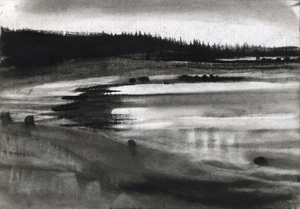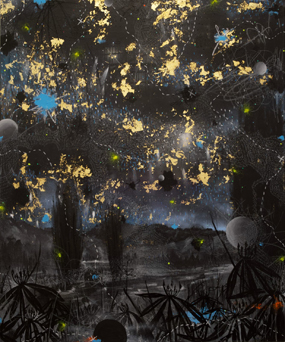North and South
John Haberin New York City
Emily Nelligan and Jake Berthot
Jodi Hays, Michi Meko, and the American Landscape
One could admire Emily Nelligan for her technique alone. Her care for charcoal on paper matches her care for the scene before her eyes. It asks one to linger over a scene, and so did she, year after year.
Her sense of time and place has another payoff as well. Each work tracks not just a moment, but the slow onset of night and day. She is observing changes over an extended moment and across generations in New England. At much the same time, an established abstract artist, Jake Berthot, was taking his darkness to landscape as well. Has change come, too, to the American South and to divisions within America, along lines of race and region? Jodi Hays and Michi Meko still see it coming, in media with themselves a history, collage and painting. 
On a return to summer
For seventy years, Emily Nelligan returned each summer to Great Cranberry Island, but it might have been one long night. The darkness is always encroaching—and always in a battle against the light. Each has its own glow, its own beauty, and its own terrors. Her subject may be moonrise or sunset, a full moon or a dark cloud itself. Yet each is at once radiant, enveloping, and penetrating. The more one looks, too, the more each is unique.
For Nelligan, the light is always changing because so are nature and time. Anyone who summers in the same spot year after year has to take comfort in the predictable. One can practically hear her and her husband on arrival, taking a deep breath and calling it home. No doubt anyone who summers off the coast of Maine does so for cool afternoons, ocean breezes, and long evening light. Somehow, though, she records none of that. She is the ultimate night person, too restless for stability—and too patient to overlook the drama unfolding before her eyes.
Her show's earliest drawing, from 1975, may be the most terrifying. A disk of light has the sky to itself, at the center of the sheet. It is surrounded by darkness, but not completely. Its rays pick up again just past a black circle, spreading outward only to die quickly away. Elsewhere the darkness takes many forms—clouds with their underside hidden from the sun or moon, distant woods, and stubborn mists. And still the light fights back.
Light may play many roles in the drama, like islands and gardens for Mary Dill Henry or a deserted road for Dana Powell, often as not in a single drawing. It can hang on above the clouds and break out below, lurk within the mists or reflect in still or turbulent water. The gallery quotes Deborah Neigall, who writes that "time is measured by changing light"—insightful but still only part of the story. Nelligan's multiple sources of light and darkness allow her multiple time scales. She is drawing not just a time of day or night, precisely dated, but successive moments in an event that takes time. She is also giving it a place in the long course of those seventy years.
Those seventy years were an entire adult life, for an artist who died in 2018 well into her nineties. It left her an outsider, far from New York and with, as Neigall has it, her "summer place." It left her an outsider, too, in her care for craft, with a medium that she could sharpen to a fine point or smudge to the texture of mist or soot. She appealed to conservative artists and critics like Wolf Kahn and Hilton Kramer at The New York Times, whom the gallery quotes as well. She could approach abstraction, making her duly adventurous, and still refuse it, leaving her duly respectable.
That left her out of the spotlight, but challenging all the same—not just in her realism or abstraction, but in what she leaves out. She has little interest in summer days or beachfronts. If the island took its name from the shape of a cranberry, one would never know it. Even more, she leaves behind any simple notion of time or light. She takes a remote island as familiar and the familiar as strange. She may stop short of greatness, given her lack of interest in her time, but the seeming modesty of drawing has its claims, too.
The builder and the visionary
Whatever happened to abstraction? Not a lot of people were asking at the time, but Jake Berthot was. He turned fifty in 1989 and in a modest career, and his future depended on it. Better yet, he had an answer ready. He for one was painting, confidently, with a murky black that could put Ad Reinhardt to shame. And yet his art was about to change. Will he be remembered as a landscape painter?
Not that he was alone in asking. Critics were, dismissively. Painting is dead, the mantra ran—or, if not dead, newly political and conceptual, no longer canvas but pictures. In the "postmodern paradox" (as I called it at the time), the critique itself kept painting alive. Embattled artists were asking, too, and I followed them to Snug Harbor, on Staten Island, to listen. They called the show "After the Fall," in exile from Soho and then Chelsea, if not from Eden.
You may remember Berthot for his dark monochrome from the 1970s. He pushed painting to the very edge of the canvas and beyond, adding strips to each side. You might think of the canvas as a larger rectangle with cuts from each corner, but he was building—not, like Lucio Fontana and Arte Povera in Italy, slashing away. Is a builder the very opposite of a visionary? Wait all you want, and distinct colors will still not pop out seemingly from nowhere, as with Reinhardt's black paintings. Paintings may have several panels, as with Ellsworth Kelly, but not with one color per panel, subordinating construction to vision.
Already, though, the builder and the visionary were both present. You may remember the paintings as thick and crusty, but their smooth surface has to make you wonder how Berthot achieved their mix of raw black and subtle color. Soon enough, though, in the 1990s, impasto took over. The painted border around a central rectangle gives the illusion that he had cut the rectangle out of the painting and replaced it with another in red, like a pillar of fire. Either way, vision had its part to play. Before his death in 2014, he returned to blackness, but in landscape.
Now a show has work from all three periods, as "What Happened to Abstraction?" Put this way, the question has another reading as well—not to claim that it had died, but to ask where he was taking it. Not that this is a "proper" retrospective. The gallery prefers contrasts and gaps in time to chronology. It leans to landscape artists within late Modernism, most notably Rackstraw Downes, and landscape here falls dead center, like a key to Berthot as a whole. And there, too, the builder and the visionary have to get along.
The builder conveys earth and sky as mass, from their very blackness. From the titles, this is the dead of night. Still, a vision appears on the horizon, with dawn's silvery white. Often these days, abstraction and representation appear side by side in a single work. Painting is back, big time, bringing with it forms from the past. The world may still not be knocking at his door, but Berthot knew when to look forward, with trepidation, and when to look back.
Deep South, deep surface
Some art is inviting but impenetrable. It hints at a deep past and unexpected depths in the present, but the real action takes place on the surface. For Jodi Hays and Michi Meko, it brings to the surface the artist's racial or gendered identity. That makes them a natural for a two-person show, for work on nearly the same scale, just larger than many an easel painting.  Giving them separate walls would almost defeat the purpose. And yet, other than all that, they are as different as night and day.
Giving them separate walls would almost defeat the purpose. And yet, other than all that, they are as different as night and day.
Any resemblance between artists is entirely on the surface. One is a white woman, the other black, and their most memorable colors are black and white. Hays calls one work Meridian, bringing the clear light of day, and Meko calls one night painting Fogland. She works in collage, he in landscape—the first looking back to Cubism, without illusion, the second in seeming defiance of Modernism. Her assemblage relies heavily on the grid, where the object itself drive the image, his painting on sudden breaks in the darkness. As he titles another work (with slightly fishy spelling) It's Not About the Fish, but the Water.
The show sees them as united by their place in the New South, whatever that means. One has been hearing about it for a long time now while wondering if anything will ever change, despite an encouraging election here and there. Hays works with dye, fabric, cardboard, and paper, which she associates with southern craft traditions. She recalls women at work weaving and sewing, while envelopes and packaging spell out their origins. Meko speaks of a scarred landscape, as it must be to many a black family. If it shines amid the darkness, An African American may desperately need signs of hope and a place to hide.
Each depends on bright surfaces and a darker history, but not with the same medium or in the same way. Hays lists dye as a material on a par with others, as opposed to dyed materials, making a point of the image as material object. Colors cut across the grid, sometimes smearing together or becoming fields of color in striking imbalance. Now and again the dyed fabric takes over completely. Still, do not count on making out the stamps or postal codes. If it helps, she was born in Arkansas and settled in Nashville after graduation from the University of Tennessee.
Meko grew up in Alabama and works in Atlanta, where a black man may always be a fish out of water. Yet he claims the water as his own. His fishy title quotes another artist, aptly named John Gill, and a painting incorporates actual fishing line. His woods at night truly are dark and deep, but he can linger there as long as he likes, and his depiction of depth relies on his brightest lights. Cut off at the top, the tall trees are all the more stubborn, but two sets of highlights leave them in the middle distance, for you to explore. Stabs of yellow litter the surface, like leaves in moonlight. Behind lies a shimmering blue and white.
The two artists have one last point of unity, in the artist's hand. She speaks of her work as Southern povera, after Arte Povera in Italy, but she is building a surface like Berthot—not like Fontana cutting it apart with a knife. Like women before her, she, too, is crafting. He in turn has those marks of the brush in yellow pushed up against canvas. There may be no single future for the South, only personal visions and contested ground.

Emily Nelligan ran at Alexandre through October 22, 2022. Jake Berthot ran at Betty Cuningham through April 15, 2023, Jodi Hays and Michi Meko at Susan Inglett through January 28.




